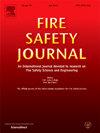社会发展和政府控制背景下的火灾风险:来自中国10年多元统计的证据
IF 3.4
3区 工程技术
Q2 ENGINEERING, CIVIL
引用次数: 0
摘要
从火灾统计数据对火灾风险进行研究,可以为区域火灾风险缓解提供一个面向全球的视角。利用2010 - 2019年中国火灾统计数据,将火灾发生频率与火灾后果相结合,构建了基于火灾风险矩阵的综合反映区域火灾风险水平的框架。在此框架下,中国大部分地区的火灾风险总体上处于中等水平。此外,还综合了区域社会经济和政府数据,以确定可能影响火灾风险的积极和消极因素。探讨了社会经济发展因素、风险管理因素与火灾风险之间的相关性,确定了4个具有统计学意义的指标:人口规模(- 0.20,p <;0.001),人均GDP (0.35, p <;0.001),收入水平(0.26,p <;0.001),国有机构和组织的从业人员(- 0.15,p <;0.01)。基于这4个相关指标,利用k近邻(KNN)、支持向量机(SVM)和随机森林(RF) 3种典型的机器学习方法,构建了区域火灾风险的解释模型,并基于统计数据对结果进行了验证。实验结果表明,基于4个具有相关性的指标可以在一定程度上解释火灾风险,在测试集上的分类准确率分别为47.31% (KNN)、53.76% (SVM)和54.84% (RF)。本文章由计算机程序翻译,如有差异,请以英文原文为准。
Fire risk in the context of social development and government control: Evidence from 10 years of multivariate statistics in China
A study of fire risk from fire statistics can provide a global-oriented view for regional fire risk mitigation. Using the fire statistics from 2010 to 2019 in China, a fire risk matrix-based framework was constructed to reflect the regional fire risk level comprehensively, which combined the frequency with the consequence of fires. Under this framework, the regional disparity was observed, and most regions in China are at a medium level of fire risk overall. Furthermore, the regional socio-economic and governmental data were integrated to identify the positive and negative factors that may influence fire risk. The correlation between socio-economic development factors, risk management factors and fire risk were explored, and four statistically significant indicators were identified: population size (−0.20, p < 0.001), per capita GDP (0.35, p < 0.001), income level (0.26, p < 0.001), and employed persons in state-owned agencies and organizations (−0.15, p < 0.01). Based on these four correlation indicators, three typical machine learning methods, namely K-Nearest Neighbors (KNN), Support Vector Machine (SVM) and Random Forest (RF), the explanatory models for regional fire risk were constructed and the results were validated based on statistical data. The experimental results show that the fire risk can be explained to a certain extent based on the four indicators with correlation, with classification accuracies of 47.31 % (KNN), 53.76 % (SVM) and 54.84 % (RF) on the test set.
求助全文
通过发布文献求助,成功后即可免费获取论文全文。
去求助
来源期刊

Fire Safety Journal
工程技术-材料科学:综合
CiteScore
5.70
自引率
9.70%
发文量
153
审稿时长
60 days
期刊介绍:
Fire Safety Journal is the leading publication dealing with all aspects of fire safety engineering. Its scope is purposefully wide, as it is deemed important to encourage papers from all sources within this multidisciplinary subject, thus providing a forum for its further development as a distinct engineering discipline. This is an essential step towards gaining a status equal to that enjoyed by the other engineering disciplines.
 求助内容:
求助内容: 应助结果提醒方式:
应助结果提醒方式:


